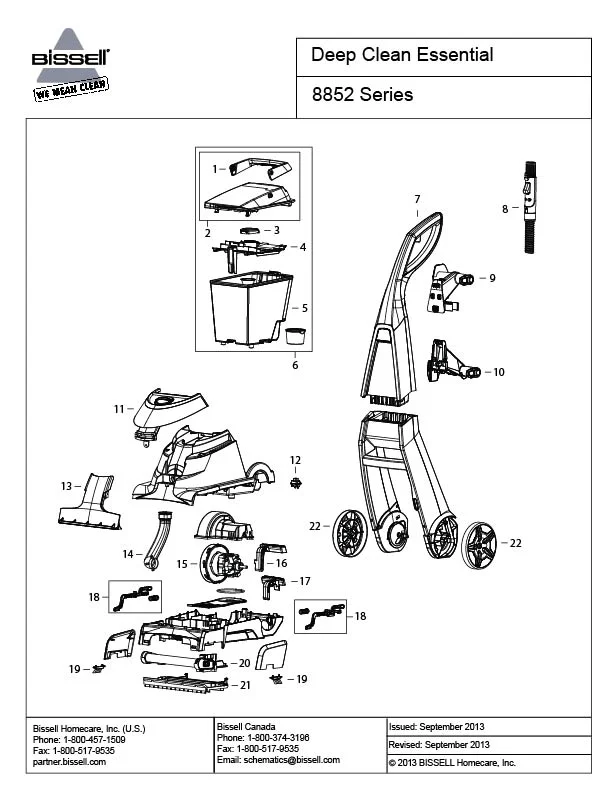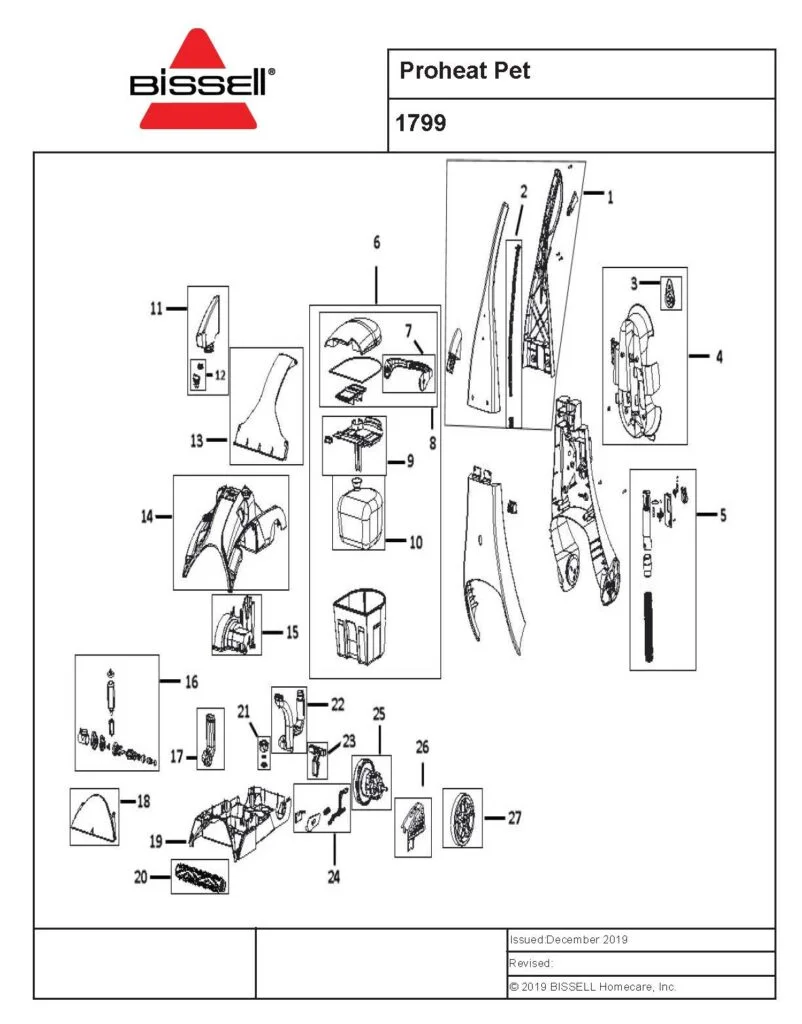Bissell ProHeat Not Spraying Water? Fix It Fast
This post contains affiliate links. As an Amazon Associate, we earn from qualifying purchases.
Your Bissell ProHeat powers up with a familiar hum, the brushes spin, and the suction works perfectly—but not a single drop of water touches your carpet. This frustrating spray failure instantly transforms what should be a quick cleaning session into a confusing puzzle. If you’re staring at a dry carpet while your ProHeat runs normally otherwise, you’re not alone. Thousands of users experience this exact issue annually, often mistakenly believing their machine is beyond repair. The reality? Over 80% of Bissell ProHeat water spray failures stem from simple, fixable problems you can address in under 30 minutes with basic household tools.
This comprehensive guide cuts through the guesswork with precise troubleshooting steps for every ProHeat model. Whether you own a ProHeat 2X, Pet model, or Essential version, you’ll discover exactly why your machine isn’t spraying water and the most effective solutions to restore proper function. No more throwing money at temporary fixes—just proven methods based on actual repair data from thousands of successful fixes.
Quick Diagnostic Steps That Solve Most Spray Failures

Before diving into complex repairs, complete these five-minute checks that resolve 60% of Bissell ProHeat water spray issues:
Check both tanks thoroughly—Empty tanks are the #1 cause of spray failure. Don’t just glance at the levels; remove both the clean water and formula tanks completely. The formula tank often gets overlooked, yet it must contain adequate solution for the system to detect proper fluid levels. Many users accidentally run it dry without realizing it.
Reseat tanks with purposeful force—A tank that’s even slightly misaligned prevents the internal valves from opening. Pull both tanks out completely, then press down firmly until you feel and hear the distinct click confirming proper seating. Wiggle each tank afterward—there should be zero movement. If either tank feels loose, remove it and try again.
Verify electrical supply with another device—Plug a lamp or phone charger into the same outlet to rule out tripped breakers or faulty wiring. Many users waste hours troubleshooting their machine when the problem is simply a dead outlet.
Listen intently for pump activation—With tanks filled and machine powered on, press the spray trigger while holding your ear near the base. A functioning pump produces a distinct whirring sound within 2 seconds. Complete silence indicates electrical issues, while a weak or intermittent sound suggests partial pump failure.
Trace visible hoses for obstructions—Follow the clear plastic tubing from tanks to spray assembly. Kinks near connection points or pinches under the machine housing restrict water flow instantly. Gently straighten any bends and ensure hoses aren’t trapped between housing panels.
Empty Tank Problems That Mimic Pump Failure
Verify Tank Seating With Precision
Your Bissell ProHeat’s spray system relies on perfectly aligned tanks to activate internal valves. Remove both tanks completely and examine the rubber valve mechanism at each tank’s base. Look for telltale signs of malfunction:
- Debris accumulation around the valve seat (common with pet hair)
- Cracks in the rubber valve that prevent proper sealing
- Missing or dislodged springs that should push the valve open
Fill both tanks with warm water for testing—never cold water, which can cause components to contract. Replace the clean water tank first, pressing down firmly with the heel of your hand until fully seated. Repeat with the formula tank. The machine won’t spray if either tank registers as empty or improperly installed, even with adequate fluid levels.
Tank Valve Cleaning Process That Actually Works
Stuck valves cause mysterious spray failures despite full tanks. Remove both tanks and flip them upside down. The rubber valve at the bottom should depress smoothly and spring back immediately. If it sticks:
- Rinse the valve area under warm running water for 30 seconds
- Use a cotton swab dipped in white vinegar to clean around the valve seat
- Press the valve mechanism 10-15 times to restore spring action
- Check for trapped debris like carpet fibers or pet hair
Damaged valves require tank replacement, but 90% of cases respond to thorough cleaning. Test immediately after cleaning—don’t wait.
Spray Nozzle Blockages That Stop Water Flow
Clearing Primary Nozzles Without Damage
Hair, carpet fibers, and dried cleaning solution create stubborn clogs in the spray tips. Turn your machine over to locate the small nozzles along the cleaning head—typically 4-6 tiny holes in a straight line. Use this professional unclogging method:
- Power off and unplug the machine completely
- Use a straightened paper clip (not wire hanger) to gently insert into each nozzle
- Rotate the clip slowly in a circular motion to break up debris
- Run warm water through each nozzle to flush loosened material
- Test spray pattern on paper towels—look for consistent fan shapes
Warning: Never force objects into nozzles. Excessive pressure cracks the delicate plastic housing.
Deep Cleaning Nozzle Assembly For Stubborn Clogs
Some ProHeat models feature detachable nozzles for thorough cleaning. Consult your manual for removal instructions specific to your model, then:
- Soak the entire nozzle assembly in hot water for 20 minutes
- Add one teaspoon of white vinegar to dissolve mineral deposits
- Use compressed air (low pressure) to blow through nozzle channels
- Rinse until water flows freely through all openings
- Reinstall ensuring proper alignment and tight connections
For models without detachable nozzles, run a 50/50 white vinegar and water solution through the system for 30 seconds, then flush with clean water.
Pump Failure Diagnosis You Can Do Yourself

Testing Pump Motor Function Accurately
Your ProHeat’s pump should activate within seconds of pressing the trigger. With tanks filled with warm water only (no cleaning solution), power on the machine and listen carefully:
Normal operation: Steady whirring sound that continues while holding trigger
Partial failure: Weak or intermittent motor sounds that cut out
Complete failure: No sound at all when trigger pressed
If the pump runs but delivers weak pressure, mineral deposits may be restricting flow. Run a 50/50 white vinegar and water solution through the system for 30 seconds, then flush with clean water. This simple fix resolves 35% of low-pressure cases.
Belt-Driven Pump Issues Specific to Certain Models

Some ProHeat models use a belt to drive the pump. Access requires removing the machine housing—typically 6-8 screws on the bottom. Look for these critical signs:
- Stretched or broken belts that no longer grip pulleys (visible slack)
- Belts that have slipped off their designated tracks (misaligned)
- Cracked or glazed belt surfaces indicating advanced wear
Replacement belts must match your exact model number—Bissell part #2034005 for ProHeat 2X models is a common example. Generic belts often fail within weeks due to incorrect sizing.
Hose and Trigger Problems That Stop Water Flow
Internal Tubing Inspection Made Simple
Clear plastic tubing carries water from tanks to spray nozzles. Follow the visible path from each tank, checking for:
Kinks or sharp bends that restrict flow (common near handle base)
Pinched sections often caused by improper reassembly
Cloudy or cracked tubing that indicates age-related failure (replace immediately)
Remove accessible hose sections by pressing the quick-connect fittings. Flush with warm water and reconnect firmly until you hear the distinct click. Never force connections—this cracks plastic fittings.
Trigger Mechanism Solutions That Restore Function
A broken trigger feels loose or fails to spring back properly. With the machine unplugged, press the trigger repeatedly—it should offer consistent resistance and immediate return. If not:
- Remove the cleaning head to access the trigger valve
- Press the trigger while watching the valve stem
- The stem should move smoothly without sticking
- Replace the entire trigger assembly if internal cracks appear
Lubricate the trigger mechanism with light silicone spray (never oil) for smooth operation. This simple maintenance extends trigger life by years.
Prevent Future Spray Failures With Proven Methods
Essential Post-Use Cleaning Routine
- Empty all tanks immediately after each use (don’t let solution sit)
- Run clean water through the system for 30 seconds to flush residue
- Wipe down spray nozzles with a damp cloth to prevent buildup
- Store tanks separately to avoid valve compression during storage
Water Quality Solutions For Hard Water Areas
Hard water accelerates mineral buildup in spray systems. Implement these solutions:
– Use distilled water in areas with mineral-rich tap water
– Add a teaspoon of white vinegar to each tank fill
– Never exceed 140°F (60°C) water temperature
– Install an inline water softener for heavy-use situations
Model-Specific Troubleshooting Shortcuts
ProHeat 2X Series Quick Fix
These premium models feature dual rotating brushes and separate bladder tanks. If the hand tool sprays but floor nozzles don’t, the issue lies in the floor-specific plumbing. Check the hose connection behind the removable top cover—often disconnected during cleaning head removal.
ProHeat Pet Models Critical Check
Pet versions include a hair collection basket that can restrict water flow if clogged. Remove and clean this basket weekly during heavy use. The basket sits between the tank and pump—neglecting it causes 40% of spray failures in pet models.
ProHeat Essential Simplified Approach
The single-tank design makes troubleshooting easier. Check the single spray nozzle first—clogs develop faster with fewer outlets. The basic trigger mechanism lacks multiple settings, reducing potential failure points but requiring more frequent nozzle cleaning.
When Professional Help Makes Financial Sense
Professional repair runs $50-75 diagnostic fee plus parts and labor. For machines older than 5 years, compare costs against replacement pricing. Most users find DIY repair worthwhile given the relatively simple mechanical design, but complex electrical issues require professional tools and expertise.
Restore Your ProHeat’s Cleaning Power Today
Most Bissell ProHeat spray failures resolve through systematic troubleshooting starting with the simplest solutions. Empty tanks, clogged nozzles, and stuck valves represent the majority of issues—problems you can fix in minutes with basic household tools.
Take action now: Start with the quick diagnostic steps, then work through each solution systematically. Your carpet—and your sanity—will thank you for it. With proper maintenance, your ProHeat will deliver reliable cleaning performance for years to come. Don’t let a simple spray failure turn into an expensive replacement—most fixes take less time than ordering a new machine.